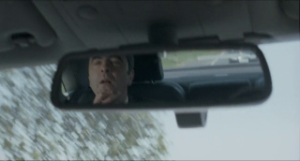Updates
'Five Minutes of Heaven': a close reading

Five Minutes of Heaven (UK and Ireland: dir. Oliver Hirschbiegel, 2009)
This film is a fictionalised account of a meeting set up between Joe Griffen, whose brother was killed in the Troubles, and Alistair Little, the UVF member who killed him.
Five Minutes of Heaven begins with the voice of Alistair Little as an adult (Liam Neeson), speaking from out of the dark screen: ‘For me to talk about the man I have become, you need to know about the man I was’. Already, it is clear that the past and the present are going to be presented together in the film; it will not be about one or the other alone.
This opening also gives the audience an intimate connection to Little – we seem to start inside his head. There is the sound of a ticking clock in the background, and time and time passing are going to be important themes. The film then cuts between darkness and Little’s face as a fifteen-year-old (Mark Ryder), and genuine archive footage of the conflict. These are memories that will be shared by most of the audience. This folds the reality of the conflict into the fictionalised narrative, suspending the film between reality and fiction.
The flashback sequence begins with shots of the outside of Little’s home in Lurgan, then his parents listening to a news report on the radio. Both the conflict and news media representations of it are deeply embedded into the lives of his family. Together, these audio and visual props place us back in the past, to 1975 – but within the mise en scene, objects and people are placed further back. The fifteen-year-old Little keeps his gun under his bed, hidden amongst his childhood toys; he stands at the mirror and examines his spots. He is still a teenager rather than a man. In voiceover, he describes the feeling of being ‘under siege’ and needing to do ‘something’: his feelings are intense, but vague. The film paints a picture of a young man at a loose end.
After the killing, the film returns to the present day. Its colour palette changes from warm to cool as we move to the present time. The visual coldness of the film at this point evokes the trauma that remains, rather than the initial intensity of the violence as it happened. However, we soon realise that the violence persists in the minds of the two protagonists. Joe Griffen (James Nesbitt) is in a car, being chauffeured to the interview. His words are almost a soliloquy; a driver is there, but barely responds. The film cuts between him and Little, also in a chauffeured car, who is calmer. It also shifts between Griffen speaking his thoughts and thinking to himself in voiceover. He appears to be trapped in his own thoughts and listening only to himself.
The mostly anonymous chauffeurs take away direct agency from both men, as they drive them towards their fate. Griffen is seen repeatedly in his car’s rear-view and wing mirrors, as though trapped by ‘looking back’ to his past, and to a great extent still living in it.
When they reach the River Finn building, we see what is intended: a planned face to face meeting between the perpetrator and the victim of an act of political violence. The structure of the meeting is an archetypal ‘transitional justice’ scenario, set up by a reconciliation project. However, this is a highly staged and closely watched encounter, designed by a TV production company. The situation is set up to be both conciliatory and confrontational: two chairs have been placed opposite each other, in a grand, airy room. We might see the architecture of the space as a reminder of the colonial history of Northern Ireland, and how the characters are obligated in some ways to live inside the persistent structure of that history, and to attempt to recover from its violence from within that space.
Little has become a well-known expert on the conflict and on reconciliation, and frequently appears, we find out, on radio and TV to share his expertise on the subject. Griffen, meanwhile, has brought a concealed knife with him, intending to live out his long-held ambition of killing the man who murdered his brother. The producer lays the possibility of ‘truth and reconciliation’ on thick to Griffen, emphasising the political significance of their meeting. Griffen’s soliloquy spills out in his conversation with the programme’s runner (as a young Polish woman, she is distinguished as standing outside the national conflict and thus outside of the past).
Griffen is asked to descend the stairs towards the enormous wooden door of the room repeatedly for more takes: he sees this as demeaning. The staging is somewhat reminiscent of Hollywood (‘you expect Bette Davis to come sweeping down!’) or a princess meeting her prince at a ball – a bizarrely hyper-‘civilised’ or ‘sophisticated’ looking choice. Perhaps he also perceives it as emasculating; he has been daubed with make-up at this point as well. The knife becomes significant as an obviously re-masculinising, empowering reply to his situation. A cameraman walks backwards down the stairs, capturing Griffen’s face as he moves. The extra takes of the approach to the door also force Griffen to remain in the pre-confrontation state for longer, heightening his emotions for the sake of the narrative progression the producers want. The demand for repetition is reminiscent of victims being forced to repeat procedures (for example, when providing their testimony), and thus forced to relive the events they experienced. This is a known, recurring issue in transitional justice and reconciliation processes, even when they are not televised.
By starting this sequence behind the scenes of a TV programme while it’s being shot, by referencing Little’s post-conflict media career, and by having Griffen dismiss the cameras before a meeting with Little can happen, the film sets itself up to take apart conventional media narratives and perspectives on the conflict, and on post-conflict discourse. It shows that it intends to explore emotions and affect which have been repressed by ‘civilised’ and ‘sophisticated’ discourse: in particular, the desire for revenge, that ‘five minutes of heaven’ that Griffen has relived repeatedly over the years, perhaps even as much as he has relived the pain of his brother’s murder.
Last modified: Sat, 28 May 2022 17:08:58 BST










